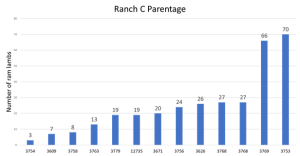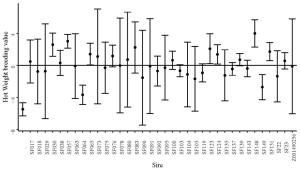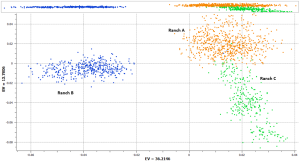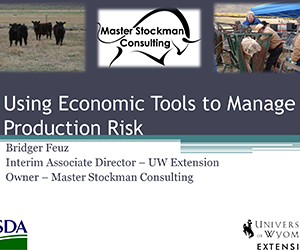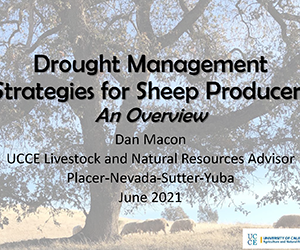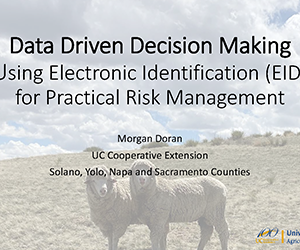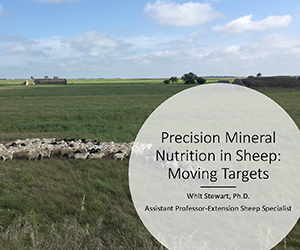Genetic Improvement and Electronic ID
Using Electronic ID tags to Improve Flock Production and Health
The American sheep industry has seen a steady decline in national sheep numbers dropping from a record 56 million sheep in 1942 to 5.23 million in 2017. A dramatic increase in production efficiency is critical to the future success and sustainability of the sheep industry. Technologies like electronic identification (EID) tags and genomic testing have been profitably adopted by other livestock industries. We are working with a group of 5 sheep ranchers in California to demonstrate and evaluate the benefits, challenges, and the economics of how information from both EIDs, and a targeted sheep genotyping panel could be incorporated into commercial sheep production systems.
There is a real opportunity to improve the production efficiency of lamb production in the United States to supply this market, through the adoption of improved genetics. Crucial to any genetic improvement program is the individual identification of animals, pedigree, phenotypic records of economically relevant traits, and more recently the collection of genotypic information.
The use of improved genetics is one of the main contributors to the sustainability of agricultural production systems. Increasing the number pounds per sheep produced has the potential to reduce the environmental footprint and emissions intensity per unit of sheep.
This page will be used as a platform to share findings generated from our collaborative team of sheep ranchers, UCCE advisors, Campus based Professors in Extension, and the largest sheep processor in California, Superior Farms.
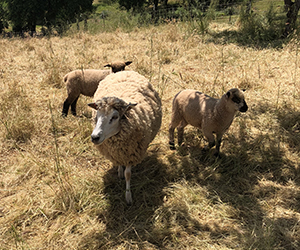
Economics and Cost
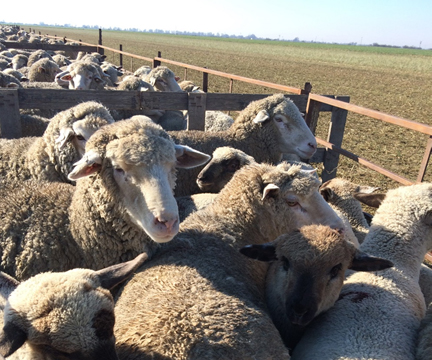
EIDs and Large Flock Research
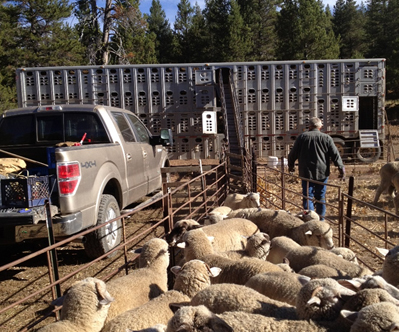
Before Adding EIDs
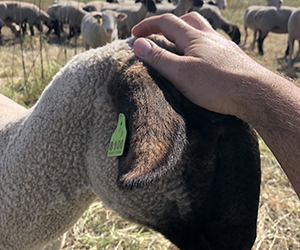
More Resources
What are Electronic ID tags?
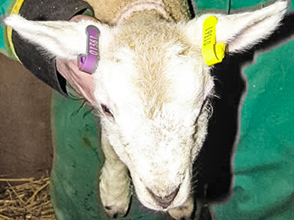
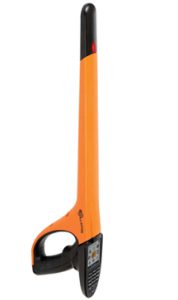
Sheep electronic identification (EID) systems utilize ear tags with embedded microchips to store unique identification numbers for each animal in a flock. These chipped tags can be rapidly read with either a non-contact handheld device or through permanently installed panel readers in a corral chute. This allows for a multitude of information (i.e. mothering, weaning weight or body score) to quickly be related to a flock database.
EID economics and cost analysis
A cost-benefit analysis comparing the cost of EID and genetic testing to projected positive change scenarios. This work will inform scenarios that focus on two aspects: a) impact to operational costs and labor needs due to electronic record keeping, and b) impact to operational costs based on expected changes in production efficiency if genetically superior rams were used based on the genotyping and phenotyping results obtained in this study. Below we highlight the economic benefits of using EIDs to select for Mothering ability and twins.
| BEFORE EID’S | AFTER EID’S | |
| Paper data sheets | Export data directly to Excel | |
| Three types of ear tags | EID and Visual tag sold in tandem | |
| Hand enter data into Excel | USDA Scrapie Eradication Program approved | |
| Tag loss rate ~ 3% | ~99% retention rate | |
| Work lambs twice at weaning | Reduce labor and cost | |
| Cost of reader |
Potential economic benefit from using EID’s to select for twins and mothering ability
| % Lambs Weaned | 90% | 100% | 110% | 120% |
| Total costs | $525,000 | $525,000 | $525,000 | $525,000 |
| # Lambs Weaned | 2,700 | 3,000 | 3,300 | 3,600 |
| Avg lbs/lamb | 105 | 105 | 105 | 105 |
| $/lamb | $1.52 | $1.52 | $1.52 | $1.52 |
| Gross Income | $430,920 | $478,800 | $526,680 | $574,560 |
| Net Income | -$94,080 | -$46,200 | $1,680 | $49,560 |
Assumptions: 3,000 ewe base flock; labor cost/rates remain stable; $175 annual cost/ewe
Research focusing on EID’s and Large, Commercial Flocks
Given the potential for EID’s to facilitate genetic change that improves the bottom line for sheep producers, we wanted to do a study that considered opportunities for the application of EID’s in large, commercial sheep flocks. Working with five ranches across California we tagged and sampled about 2,500 rams and lambs; mostly lambs. Genetic samples were submitted to Superior’s Flock 54 program. Using the genetic analysis we determined parentage and connected lamb carcass traits to sires, see Ranch A and Ranch B below. Data analysis presented is preliminary.
| Ranch A | Hot
Weight |
Yield
Grade |
Quality Grade | Breast | Rack | OCC
Yield |
| n=209 | ||||||
| AVERAGE | 73.5 | 2.7 | 8.9 | 8.2 | 67.8 | |
| STD | 10.2 | 0.5 | 1.8 | 1.2 | 1.1 | |
| MIN | 50.4 | 1.4 | Good | 4.4 | 5.1 | 63.9 |
| MAX | 102.4 | 4.2 | Choice | 14.2 | 12 | 72.6 |
| Ranch B | Hot
Weight |
Yield
Grade |
Quality Grade | Breast | Rack | OCC
Yield |
| n=315 | ||||||
| AVERAGE | 76.1 | 2.7 | 9.5 | 8.7 | 67.3 | |
| STD | 11.6 | 0.5 | 2.0 | 1.4 | 1.1 | |
| MIN | 41.1 | 1.4 | Good | 3.4 | 4.3 | 64.3 |
| MAX | 106.9 | 4.6 | Prime | 14.6 | 12.5 | 71.4 |
Selected results from Flock 54 genetic testing are presented below. The first graph on the left shows parentage testing results from Ranch C. Analysis indicates that ram performance is similar to documented results from genetic testing in beef cattle, where just a few males breed over 50% of the females. Expected breeding values were developed for Ranches A and B based on carcass traits collected with Superior Farm’s state of the art camera grading system (middle). The principle component analysis plot on the right displays the genetic differences among sampled individuals.
The number of lambs sired by ram for Ranch C. This figure displays the number of male lambs sired by ram. Typically, there are about the same number of male and female lambs born per sire. Each ram is expected to cover 40 ewes on average. We analyzed 329 lambs with the average number of male progeny being 25.3
This graph displays expected breeding values for each ram from ranch B for the hot carcass weight breeding value. Each number on the bottom axis is a ram. The lines on the chart represent the breeding value. Shorter lines indicate a greater number of lambs were sampled and improved predictability for the trait. Number of lambs sired for selected Rams were SF057 = 21, SF064 = 20, SF139 = 31
Thoughts to consider for implementing EIDs in your operation
There are two key points to keep in mind when considering transitioning to EID’s as a tool for genetic selection:
- Desire to see improvement in your flock
- Clearly defined objectives
In the case where a producer is mostly satisfied with the performance of their flock, EID’s may not be the right choice. If a producer sees opportunity for improvement in their flock and they have some key areas in mind, EID’s could be an effective tool. For example, maybe a producer would like to increase the number of lambs weaned per ewe exposed. There are a few traits that could be tracked using EID’s to increase the number of weaned lambs, they include: birthing rate of ewes (percent ewes bred and lambed), twinning rate of ewes (more lambs born), mothering ability of ewes (ewes that can count to 2), and lamb vigor (greater lamb survival in the first critical hours after birth).
There are many things to consider when transitioning to using EID’s. One idea is to test the tags and process on a portion of the flock first and scale up later. It’s important to monitor progress towards goals and be patient as breeding stock changes and replacement animals reach maturity. In some cases, producers may be interested in EID’s but looking for a way to make simple changes in their flock first. The most effective way to create change in a flock is through careful sire selection. If a Suffolk ram has two productive years he will produce, on average 80-100 lambs. The most productive ewe will likely only bear about 10 lambs during her lifetime. Producers can use Estimated Breeding Values (EBV’s) to select the best rams available for their flock. Careful culling of non-productive animals is also a highly effective way to create rapid change.
After a record high of 56 million sheep in the U.S. in 1952, sheep numbers have steadily declined and continue to fall 1-2% each year. Meanwhile, over 60% of lamb consumed in the U.S. is imported. In other words, there is incredible opportunity in the lamb industry in California and across the U.S. to supply a high-quality, in-demand, domestic product. Careful selection of breeding stock through strategic culling, using EBV’s to select rams, or using EID’s to track important production traits are some of the tools producers can use to take advantage of this opportunity.
What do producer's have to say about EID's and flock improvement?
Using electronic ID tags to track and record individual animal performance data streamlines genetic selection in sheep flocks. Producers who have used EID’s say:
- When you’re tending to 5,000 to 8,000 sheep (5 to 8 “bands”) every year, having every ram, ewe and lamb microchipped saves ranch hands both time and labor while increasing information accuracy.” Evan Helle (AG Daily, 11/5/20)
- “Cull wasteful sheep”. First year using EID’s in commercial flock culled 170 lb fancy ewes that weaned ~65 lb lambs at 4 months. Second year, less grafting in the lambing shed because more of the ewes could care for twins. Targhee breeder, MT
- Reduced foot rot issues through genetic selection. Also, increased twinning rate (lambing percentage) and improved flock health. Emigh Livestock
- “Increased percent lambs weaned from 85% to 115% and decreased medical costs per ewe by more than $10/head.” CA producer
Additional Resources
- Macon, D. 2018. Electronic Identification Systems for Small-scale Livestock Producers: A Case Study. Publication #31-1009. November 2018 https://ucanr.edu/sites/Livestock/files/294788.pdf
- Sheep Stuff Ewe Should Know Podcast: Tech Tools to Better Manage Data. June 4, 2020
- American Lamb Board - Lamb Resource Center – Productivity Resources https://www.lambresourcecenter.com/productivity-resources
- Leading Edge Sheep Production – Mickel Brothers Sheep Company and NSIP rams http://nsip.org/wp-content/uploads/2021/02/Leading-Edge-Final-Report.pdf
- National Sheep Improvement Center and Sheep Genetics USA
 This project and webpage was funded through the USDA Western Sustainable Agriculture Research and Education program.
This project and webpage was funded through the USDA Western Sustainable Agriculture Research and Education program.

